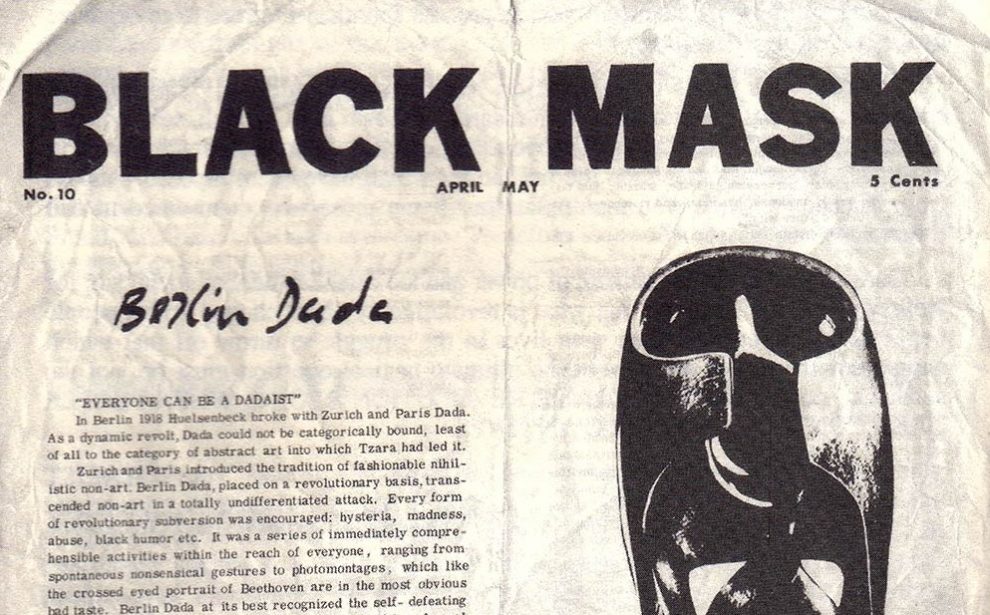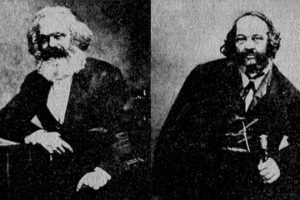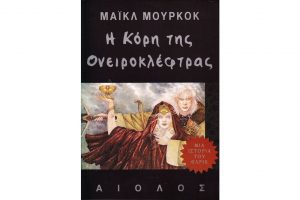Dan Georgakas is a Greek-American artist, activist and historian, writer of the famous “Detroit: I Do Mind Dying. A Study in Urban Revolution” and a historical member of the Cineaste Magazine’s Editorial Committee. He was also a member of the New York Anarchist Group Black Mask – later named Up Against the Wall, Motherfuckers – but also founder of the radical anti-dictatorial committee Ritsos-Z-Theodorakis. Born and raised in the motor city of Detroit, once the heart of American industrial capitalism, he actively participated in the workers’ movement, the anti-racist movement of solidarity with the blacks and against the Vietnam War. Around May 1968 he developed relations with many organizations of the left in Europe and the US. In the interview he gave us, he talks about his life, about the political and activist thread that unified all of his activities, forming with his narrative a special mosaic of the various movements in the USA in the 1960s. The film “Dan Georgakas. A Diaspora Rebel,” by Kostas Vakkas, shot in 2015, is dedicated to his life.
You were a core member of the NY-based anarchist group Black Mask and later of Up Against the Wall Motherfuckers. Abbie Hoffman characterized it as “a middle-class nightmare.” During that same period, you became an active member of the editorial collective of the nascent Cineaste and you founded the Ritsos-Z-Theodorakis Committee, a radical anti-junta committee. What was the broader radical engagement uniting those interests?
The roots of my politics are in my upbringing in a multi-ethnic working-class neighborhood in Detroit during its most prosperous years. Despite huge problems of racism, workers were militant. Many of them had participated in the violent organizing drives of the 1930s. They expected to own cars, homes, and even vacation cottages. Most had never graduated from high school, but their children often went to college. The Greeks in that community were immigrants. Most were production line workers or owners of bars and diners adjacent to factories. I’ve written about them in My Detroit: growing up Greek and American in Motor City. Here, it is sufficient to say the American dream had worked for them. They had arrived in poverty and now enjoyed the comforts of what they called middle-class America. Despite their success, they were New Deal Democrats, not conservative Republicans. A few family friends spoke positively of Russia, but Greek leftists had no public visibility. I was not much involved with the church or Greek social organizations. I was far more interested in the rebellious Beat poets and the poetry of Cavafy.
How did those interests generate social activism?
I looked at America with an ethnic third eye, seeing societal failures as well as successes. In 1958, with college friends, I launched Serendipity, a literary magazine that sought to resurrect the political passions of the artists of the 1930s. We were the first Detroit journal to have African Americans on its editorial board and to include black and white artists as contributors. A few years later, I was involved in the UnStabled theater/coffeehouse. It had two directors: socialist Edith Caroll Cantor, a white woman, and Woodie King, a black director/producer. We had integrated casts, a Detroit first, and produced works of black as well as white playwrights. We also wrote a show for the United Auto Workers that celebrated the historic union breakthrough victory in Flint in 1938. We performed the play in Flint for an audience that included many veterans of the strike. I also was one of two whites who worked part-time for a small black-owned night-life journal based in the black community that hoped to eventually attract white readers.
Your political views seem focused on civil rights.
Well, I think racism is the cancer of American society. Conventional education did not offer satisfactory explanations of that relationship. This prompted my attending lectures by three local radical groups: News & Letters, Facing Reality, and the Friday night socialist forum. News & Letters was headed by Raya Dunayeskaya, who had been one of Trotsky’s guards in Mexico. She advocated a theory she called Marxist Humanism that opposed the vanguard party concept, but I found her personality quite authoritarian. Due to her writing I became aware of the work of Herbert Marcuse.
Facing Reality espoused the views of C.L.R. James on how black workers would lead the second American Revolution. James Boggs, who would write the influential The American Revolution: Pages from a Negro Worker’s Notebook, was a member until he left to form his own group. Through Facing Reality, I learned about the work of Cornelius Castoriadis, co-founder of the Socialism or Barbarism group.
The Friday night socialist forum was sponsored by the Socialist Workers Party, the largest Trotskyist group in America. Rather than just presenting the SWP’s party line, the forum featured speakers from a variety of activist groups. At those lectures, I befriended African Americans such as John Watson, Luke Tripp, and Ken Cockrel who would later be founders of the League of Revolutionary Black Workers. Few people who frequented the forums with any regularity joined the SWP. Most found it very dogmatic and rigid. Nonetheless, the forum was a great place to meet others with a leftist orientation. It also resulted in my involvement in civil rights protests organized by African Americans.
A conviction I came to in those years was that workers’ control of the revolutionary movement was essential for ending the capitalist world order. I also felt that no progress could be made on race issues unless blacks were the leadership.
You then left Detroit to go to New York
Not directly. In 1964-1965, I was a high school teacher in Rome where I became acquainted with two extra-parliamentary groups: Potere Operaio (Workers Power) and Lotta Continua (Continuous Struggle). A third contact was with the Partito Socialista Italiano di Unità Proletaria, PSIUP (Socialist Party of Proletarian Unity), a parliamentary party. In the summer of 1965, during one of several trips to Greece, I observed massive anti-monarchical demonstrations in Athens. Back in Rome, I took part in a major anti-Vietnam war event at which one of my poems was read and James Baldwin was the major American voice. That activity rendered me persona non grata in the mainstream American community. I decided to move to New York’s East Village, a center of radical arts and politics.
You became a member of Black Mask. What was it trying to accomplish?
We thought revolutionary art did not just serve revolutionary thought but was revolutionary thought. Ben Morea, the founder, of Black Mask was a painter who only used black and white and was influenced by Eastern European avant-garde artists. He was well-versed in anarchist thought and admired Bakunin. I was more an anarcho-socialist who admired Kropotkin and the Industrial Workers of the World. Ron Hahn, the third member of the core, shared Ben’s perspectives.
Our events mainly revolved around the arts, but not exclusively. We attended one SDS national convention with hopes of forming an anarchist block. That didn’t happen. We also worked with a plethora of anarchist groups in New York to create an active network. Murray Bookchin, a former Communist and future author of Post-Scarcity Anarchism, partnered in that effort. It, too, failed. We were in contact with the Chicago Surrealists and with Harlem writers associated with Le Roi Jones. I have been told we were the first American group to wear balaclavas in public protests.
One of our public disputes was with Abbie Hoffman. He charged us with inciting rioting at public events. We were angry with him because he had brought a police captain to community meetings planning demonstrations. Some of the debate was on public radio. In retrospect, it was a misunderstanding on both sides.
The Black Mask core at its height was never more than ten even after two Dutch expatriate Situationists joined us. More significant was that we had scores of people who would take part in events such as our Wall Street is War Street march. Nonetheless, by late 1967, Ben concluded Black Mask must stage more provocative and disruptive events with a name change to Up Against the Wall, Motherfuckers. I was dubious about some of the new recruits, speculating some were cops and at least one was a lunatic. I gradually drifted away from the group which went on to do some spectacular and positive actions. The major reason for my shift in activism was the coup d’état in Greece.
We have some knowledge of Greek American radicalism during the 20s and 30s. We know much less about the dynamics of the anti-junta movement and its aftermath.
I thought antipathy to the colonels would result in a mass organization of outraged Greek Americans. I thought I could introduce them to some of Black Mask’s daring. I also was motivated by black friends who thought the best help whites could offer them was to organize our own communities. I was appalled that the Greek Orthodox Church, the Greek American press, and social organizations like AHEPA either supported the junta or thought a few years of iron rule were needed to keep Greece democratic. I was even more shocked by the timidity of the main anti-junta committee. At one point, it didn’t want to include left-wingers in pleas for freeing political prisoners. I formed the Ritsos-Z-Theodorakis Committee to spur the major committee. As my group grew larger, Costas Stergiou, who had a pro-Soviet orientation, became co-chair and we changed our name to Democratia. Some of our events drew hundreds of people.
The main anti-junta committee moved to the left when Melina Mercouri became directly involved. I worked with Spiro, her brother, to build American support on college campuses. Our largest demonstration of more than a thousand people was led by Melina. I was a speaker and forcefully advocated a left analysis that was well received. Democratia also persuaded a left-wing recording company to produce American editions of Theodorakis’ famed Romiossini and Mauthausen albums.
A positive long-term result of our rather weak anti-junta movement was that many radicals became active in Greek media and Modern Greek Studies. Over the years, we have achieved some success in restoring Greek American radical history at a popular and scholarly level.
How does your involvement with Cineaste fit into this scenario?
I became aware through various left-wing contacts who knew of my love of film that Gary Crowdus was seeking people to help him transform his newsletter on film into a magazine. This was a time when there was scant coverage of any non-English language films, especially those with a radical orientation. I and the other new editorial board members, all of whom were leftists, hoped to fill that void. Our first major interview was with Costas Gavras who spoke about his just released Z. A more specific goal which proved successful was to help restore the film credits and critical assessment of scriptwriters and directors blacklisted in the 1950s. My Cineaste commitment also led me into becoming acquainted with and then promote quality Greek films in America. In 2017, Cineaste, now identified as America’s leading magazine on the art and politics of the cinema, celebrated fifty years of continuous publication.
The campus-based opposition to United States involvement in the Vietnam War combined with support for the black liberation movement gave birth to a number of radical left-wing organizations such as the Students for a Democratic Society and the Weather Underground Organization. Did such organizations have connections with the volatile period of civil unrest in France? Was there a communication, collaboration or exchange of ideas with movements abroad?
The short answer is that contacts were mainly spiritual: if they can do it there, we can do it here. The influence of European thinking became stronger in the 1970s when translations were available and the Left resurgence in the academy temporarily opened new doors. Weatherman was mainly influenced by and associated with factions in the black liberation movement who advocated immediate armed struggle. Aside from coordinating dates for marches, I don’t believe the anti-war movement had many direct contacts with Europeans. We must bear in mind, however that SDS was so loosely organized that national leaders often didn’t even know who headed local chapters. So, there may have been contacts not widely publicized. A definite contact existed between the League of Revolutionary Black workers and Italian labor-oriented radicals. One fanciful proposition was that at some future time, there might be strikes in Detroit and Turino on the same day with the same demands. Finally Got the News, the League’s film about itself, was screened at Italian worker clubs.
Fredric Jameson has described the events you write of in Detroit: I Do Mind Dying. A Study in Urban Revolution as “the single most significant political experience of the 1960s.” Yet, the remarkable story of the League of Revolutionary Black Workers, is almost forgotten. Can you discuss the importance of the League in the context of its appearance and its legacy, especially its electoral, gender, and workplace history?
I think the League has been neglected by mainstream academics and media precisely because it successfully organized black workers in Detroit and inspired similar groups elsewhere in the country. A socialist-oriented back working class was the capitalist establishment’s worse nightmare. Even if a general strike only involved black workers, American society could not function. Radicals spoke of Detroit as America’s Petrograd.
Attacks on the League were constant but carried out in unspectacular ways to avoid headlines. While knowledge of the League is limited, Detroit I Do Mind Dying has been in continuous print for over forty years. So, activists are still studying the League’s history. The founders of Black Lives Matter were influenced by the League practice of multiple leaders and considerable autonomy for local units.
Although League leaders often referred to themselves as Marxist-Leninist, their methods and thinking were more in the mode of anarcho-syndicalism. They considered radicalizing the Democratic Party a hopeless endeavor, but they vigorously sought elected union offices they thought they could win. After the League dissolved, Mel Ravitz, Ken Cockrel’s law partner, ran for and won a judgeship in the Detroit’s criminal court. His rulings resulted in some control of questionable police arrest practices and he became known for setting reasonable bails and sentences. Cockrel later successfully won a seat on the Detroit’s nine-person city council. He was preparing for a mayoral bid when he died prematurely of a heart attack at age 50.
As far as gender issues are concerned, the League was no better than most organizations of that time. Mike Hamlin, one of the League’s six leaders, all male, was exceptional in consciously struggling to obtain more power for women in the League.
Despite collaborations and various alliances some of the most potent movements and organizations during the 1960s appeared to be divided along racial lines. Did you see such divisions at work? How does that reflect on today’s movements like Black Lives Matter and Never Again?
I think one of the lesser-told stories of the 1960s is the considerable cooperation between many white radicals and black radicals. I will concentrate on Detroit examples involving bookstores, book clubs, publishing, and media. In concert with League leaders, white radicals established From the Ground Up bookstore as an education resource for the Left. White women were instrumental in creating the Control, Conflict and Change book club that provided joint reading and analysis of radical books. Sessions usually attracted three hundred people and League activists led most of the group discussions. White radicals also participated in the editing and writing of the local university’s daily newspaper when it was edited by John Watson. No coincidently, Watson gave me the first four pages of one issue to present a radical vision for the anti-junta movement. In addition to the usual thousands of copies distributed on campus, in factories, and at community centers, he mailed out multiple issues to a list I prepared of anti-junta groups all over the United States. A project with very long-term consequences was that three white filmmakers working in concert with the League created Finally Got the News, a film that remains in commercial circulation.
The Detroit experiences had counterparts elsewhere. Of course, when blacks insisted on all-black formations, some white radicals who had worked in integrated groups were bitter about being excluded. Black militants of the 1960s, however, thought their prime duty of organizing the black community was at a stage when all-black formations were necessary. White radicals who accepted that reality could support that effort in ways I have just indicated. White and black radicals who believed resistance movements must be integrated had to forge their own pathway.
Regarding the current movements in U.S.; while any direct linkage between groups like Black Lives Matter and Never Again is highly improbable, there are many parallel concerns and structural approaches. There are no studies available of the highly decentralized Black Lives Matter regarding its formal and informal membership, but this black-led movement welcomes and gets support from whites. In areas of western Massachusetts I am familiar with, where the African American population is sparse, support committees are often majority white.
The Never Again movement is also decentralized with many support groups emerging without direct recruitment. From its inception, Never Again was multi-racial, gender inclusive, and multi-religious. At its massive Washington rally, the featured speakers, all students, included African Americans, an Ethiopian, and various Hispanics. Most promising at that rally was the connection made between gun violence in inner cities, mainly affecting African Americans and Hispanics, and the more specific issue of gun violence in schools. If this perception is developed, it would transform a single-issue movement into one that addresses the wider issue of the violence endemic in American popular and police culture. That could bring Never Again to joint projects with Black Lives Matter.
The 1960s are remembered for so much that changed and for so much that did not. From a historian’s perspective, but also as someone who had an active role as organizer, scholar and artist throughout this time how would you assess the events closely associated with May ’68 and the period in general.
When asked to evaluation the French Revolution, Zhou Enlai replied it was too soon to tell. I feel that way about the 1960s. The short-term failures are evident, but the movement was the seedbed of subsequent important movements, most visibly, the gay and feminist movements. Income gaps and educational gaps between whites and blacks have narrowed but remain significant. Police violence remains rampant. Nonetheless, we have come quite a distance from the 1950s when, even in Detroit, blacks were refused service at most restaurants and it was physically risky for mixed race groups, much more for couples, to gather in public places. The idea that Americans would elect a moderate Afro-American to the presidency in 2008 would have seemed a fantasy in 1968.
The latest waves of resistance to police and state violence, government sanctioned corporate greed and assaults against labor in Europe, the Middle East, the United States and beyond have proven wrong the post-1960s forecasts for a return to some kind of normalcy. In recent years protests with various goals and values combining demands typical of class movements with themes of “new social movements,” as these emerged in the 60s and onwards, like environmental issues or gender equality, have rocked the world. Could you draw any comparisons between this rather global opposition to neoliberalism and the mid-twentieth century revolutionary waves?
What we refer to as neo-liberalism is global capitalism adapting to or forging new exploitative relationships, often skillfully using mass media and social media to do so. I am encouraged by resistance to that plague, but I am disheartened when I see contemporary movements recycling behavior that has proven unsuccessful. I hope we can reject authoritarian party formations that are mini-autocracies even when they have no political power. We also need to get beyond loosely-organized groups that disintegrate when the state asserts its considerable power. I think we need to reconnect with the creativity exemplified by the French May. Fundamental social change cannot occur without an inspiring vision. To imagine something is the first step to realizing it. I, for one, feel that collective ownership of the new technologies would reduce the workday to a few hours while skyrocketing the quality of life. I can imagine non-authoritarian governance. I am now an octogenarian, but for me, the slogans of the French May ring true. Be realistic! Demand the impossible!








